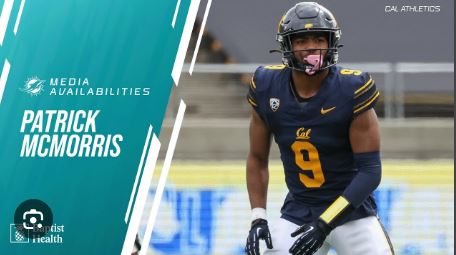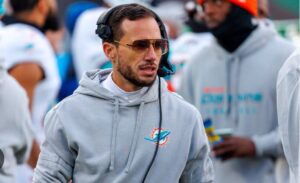
What a film analysis reveals about Miami Dolphins sixth-round choice Patrick McMorris, where he excels, where he has to improve, and what his future role as a rookie could be.
The 2024 NFL draft has ended, and the Miami Dolphins are hoping that their seven-player class will help them take the next step and make the playoffs.
Miami’s selection featured a first-round pick for the first time since 2021, a second-round pick, and five picks on Day 3, including a trade to return to the fourth round.
Our video dissection series continues with Patrick McMorris, the Dolphins’ No. 198 overall pick in the sixth round out of California. McMorris played four years at San Diego State before moving to California for his fifth season.
Over the course of five seasons, he recorded 252 tackles, 11.0 tackles for loss, six interceptions, 23 pass breakups, two forced fumbles, and four fumble recoveries.
McMorris started 40 games in college, but does he have the ability to join the Dolphins’ roster and contribute? Let’s plunge in and discover what the film has to say.
Patrick McMorris’ Coverage Ability
McMorris has experience playing all three safety positions, which is one of his strongest assets. He has 357 snaps at free safety, 247 in the box, and 171 at slot cornerback.
However, McMorris lacks the necessary speed and range to play free safety in the NFL. He is unable to close zone windows quickly enough to make plays on the ball or prevent receivers from falling behind for huge plays.
He performs significantly better closer to the line of scrimmage, functioning as a pseudo-linebacker. He has strong instincts for finding receivers in zone coverage and making plays with the ball.
Although he only had three pass breakups and one interception this season, the majority of them were excellent plays from the box.
His slot reps are somewhat hit-and-miss. He has sufficient arm length (66th percentile wingspan) and physicality to compete with tight ends, particularly on shallow route concepts.
McMorris lacks the speed and change of direction skills required to match up with shifty slot receivers, therefore his man coverage abilities are primarily matchup-specific.
If McMorris is expected to keep an eye on the backfield and break downhill, he can provide good coverage. That role is becoming more robust around the league, as more clubs employ three safety packages.
The Ravens used a lot of three-safety looks last season under new defensive coordinator Anthony Weaver, so it’s easy to see why McMorris’ skill set would be worth considering.
Patrick McMorris’ Run Defense
McMorris is a really frustrating run defender on film. He has the physical mentality you want in a defensive back, but he doesn’t use those abilities efficiently.
His explosiveness coming downhill helps him to close the gap with good timing, and he does not avoid contact. McMorris is a serious run-stopping threat when he is on his game. He has enough length to wrap-up tackle outside of his frame, and he possesses good hitting power when he arrives from deep.
He’s also an astute run defender who will take good angles, avoid blocks, and push runners back inside, where he’ll have more support from second-level defenders. McMorris played a lot of weakside linebacker last season and showed great promise.
The only thing keeping McMorris back is his awful tackling. According to PFF, McMorris’ 24.1 missed tackle percentage ranks seventh among 2024 draft-eligible safeties who played at least 200 run defensive snaps last season.
On film, McMorris misses tackles for two reasons. The first is that he does not use his length to wrap up tacklers falling to the ground. He makes contact, but doesn’t finish the play, allowing more skilled ball carriers to escape.
The other issue is that he comes into contact imbalanced. He does not remain square to his target, allowing them to avoid him and burst into open grass. McMorris’ aggression results in some big plays, but it also makes him extremely erratic.
Bad tackling in the safety position is much more significant than at other positions because safeties are sometimes the defense’s last line of defense.
If a ball carrier or receiver gets past a safety, a 10-yard gain can rapidly turn into a score. Morris is expected to play in the box more frequently than not, which may limit the number of big plays he allows.
However, this constraint limits his versatility against the run and how Miami may use him in specific packages.
The Bottom Line With Patrick McMorris

McMorris’ appraisal is far more basic than others we’ve conducted for Miami’s draft picks. His biggest chance of making the squad will be on special teams, as he does not play a significant role on defense.
McMorris has enough room in the Dolphins’ safety room based on numbers alone. Jevon Holland and Jordan Poyer are the team’s only listed safety (excluding undrafted rookie free agents). Elijah Campbell, designated as a defensive back, will also be involved in the safety room.
Still, with only three players, there is plenty of opportunity for McMorris to make the roster, especially if the Dolphins plan to utilize three safeties on game day.
Based on his film, the Dolphins might be better suited signing another safety in free agency rather than relying on McMorris. He has too little coverage experience and is too inconsistent in run defense to play substantial snaps as a rookie.
The good news is that his physical demeanor fits well with special teams. If the Dolphins can improve his tackling, he has the potential to make an impact there.
Remember that sixth-round picks are not guaranteed to make the final roster, so this would be a win for both the pick and McMorris.
Even if he remains on the practice squad for the 2024 season, that does not imply the pick was a complete failure. Just don’t expect McMorris to make a significant impact on defense anytime soon.







